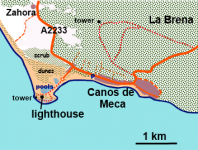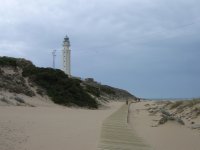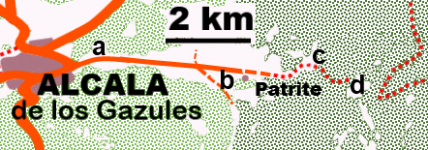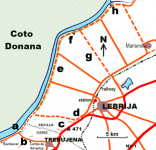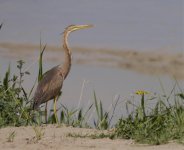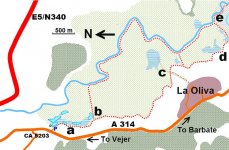Mon 23rd April 2012
A morning walk along the Molinos valley with Allan and Gill was a little quiet partly because it was mid-morning by the time we started. Birds seen included 4+ Cirl Bunting (which Allan particularly wanted to see), 8+ Serin, a Black-eared Wheatear, 6+ Woodchat, a Whitethroat, Sardinian Warbler, Bonelli's Warbler, Iberian Chiffchaff, Firecrest, several small Bee-eater flocks, 5-6 Short-toed Eagle, 3+ Booted Eagle, a couple of Common Kestrel, a single Egyptian Vulture and numerous Griffon Vultures. After much searching I located a very distant Blue Rock Thrush – another bird Allan wanted to see – on crags above the final ruined 'molino' at the end of the walk.. Once easy to see at the start of the walk this species appears to have declined in recent years. Finally, a small snake on the footpath back proved to be a Lataste's Viper – a reptile tick.
Then we went off to Canterranas area hoping to show Gill an Hoopoe – one of the few birds that she wanted to see. I soon picked up Calandra Lark – a lifer for Allan – but the target was elusive to the point of invisibility! A drive through the olive groves failed to get Hoopoe, but did locate a small Bee-eater colony – a useful find. A detour via the bustard site was a 'no show' as there were farmers in the vital favoured field. However, there were 4-5 Montagu's Harrier here and I was able to confirm that, this way in, there was no sign banning 'unauthorised' traffic so we took the scenic route back to the Alcala road. The usual 30+ Lesser Kestrels were around the house that evening.
Tues 24th April 2012
A very chilly morning on the terrace with a gusting wind, but far more birds. A spiral of Griffon in the valley was a sign of things to come with at least 200 birds drifting over as the morning wore on. Also of note were 8+ Booted Eagle, 6 Black Kite, a Common Buzzard, an Egyptian Vulture, 80+ Bee-eaters and 300+ Common Swift (but, surprisingly, no Pallids or Alpines). Lesser Kestrel as ever tried to upstage the larger raptors by their acrobatics and constant chorus of chattering calls. Astonishingly, Short-toed Eagle still elude me from the terrace this April despite seeing them so readily yesterday in the Molinos valley. In the early afternoon we were joined by our non-birding guests, so birding for the day was curtailed.
Wednes 25th April 2012
I awoke just after 7:30 to find the valley once again cloaked in thick mist. Our plan was to take our guests to Jerez which they'd never visited. So we pottered round Jerez for the day, visiting the castle and our favourite cake shop. Consequently birding was limited to what we saw from the terrace and the odd bird in Jerez – mainly Lesser Kestrels, swift sp. and the odd Griffon Vulture, although a Stone-curlew flew over the road as we passed Laguna de Medina.
Thurs 26th April 2012
As usual the Lesser Kestrels performed well this morning with a supporting cast of Griffon Vultures. We, that is ourselves and Jour guests, went south today with Punta Secreta being our first stop. Here there was a steady, if slow, stream of raptors overhead – an Egyptian Vulture, 20+ Black Kite, 10+ Booted Eagle, 6-7 Short-toed Eagle and a lone Black Stork (plus a Gannet beating along the shoreline). From there it was along the coast towards Tarifa and beyond. A brief stop near the park information centre produced a sighting of a camera shy Monarch butterfly We returned to Alcala via La Janda to show our guests the egret colony (where we also had several Turtle Dove and a Woodchat). Back in Alcala 20+ Lesser Kestrel did their stuff and 20+ Black Kites, with rather more Griffons, slipped into roost – but still no Short-toed Eagles
Friday 27th April 2012
A dull and overcast morning which dampened even the Lesser Kestrel's usually joyous start to the day. Our guests departed back to Granada this morning so we headed up to Jerez to buy a bookshelf and as we drove north the rain grew heavier. However, the clouds lifted and sun came out so after a visit to IKEA we drove over towards Sanlucar. Unfortunately, the usually reliable 'Martin Miguel' pools partincole colony was deserted, but the half dry second lagoon had several Spoonbill, 50+ Whiskered Tern and c100 Gull-billed Tern. A quick look at Bonanza salinas produced numerous Dunlin, Curlew Sandpiper, Redshank (more than I'd seen here before), a few Little Stint and rather more Sanderling. Also present were Flamingo, Avocet, Black-winged Stilt and a handful of Slender-billed Gull. Laguna Tarelo had 8 White-headed Duck plus Night & Squacco Herons, Spoonbill, etc in the heronry. The drive along to Trebujena had more waders than usual as the lagunas were shallow, but for the first time in several years I couldn't find any Marbled Teal here (I later heard some had been seen at Tarelo). Birds seen included a few Common Sandpiper, 70+ Spoonbill, a few Flamingos, 3-4 Purple Gallinules, some Red-crested Pochard and my first Red Kite of the visit. Those larks that crossed my path – literally so – all appeared to be Crested, but I was pleased to see a few Spanish Yellow Wagtails and a lone Tawny Pipit. I explored the road at the far end of the drive along the Guadalquivir a little further than previously as it not seem in quite such a bad condition. There were many pratincole here and the small salinas has an obliging Squacco and a Great-white Egret. Another quick stop at Laguna de Medina demonstrated once again how few birds were present – 9 Red-crested Pochard, a couple of Pochard, 6 Black-necked Grebe, Dabchick & Great-crested Grebe. Then it was back home to the Lesser Kestrels.
Saturday 28th April 2012
Yesterday's dull and overcast morning was replaced by a distinctly wet one. Hence I started to assemble a bookcase we got yesterday, but this activity soon lost what little attraction it possessed when I developed a blister through over use of a screwdriver. So it was off and out to Benalup to visit the museum in Hotel Utopia …. which, naturally, was closed! With the weather improving we headed off to explore the recently resurfaced the caňada that forms the eastern rim of La Janda. This proved an interesting option with several charming Red-rumped Swallow, 5-6 Woodchat, a particularly handsome pale Black-eared Wheatear, a couple of Common Buzzard, 3+ Montagu's Harrier, dozens of Black Kite, tens of Booted Eagle, 2 Black-winged Kite, ever present Griffons, numerous Calandra Lark (often posing on the track just out of telephoto range!) and several flocks of Bee-eater. The track was surprisingly good until we reached the latitude of Tahivilla when a large pothole proved too much for Liz's sensibilities and we turned back. With care, though, I suspect we could have continued. So it back along the track towards Benelup and on to Alcala. Stopping at Ajibe visitors' centre for a coffee and walk round the garden, we had 5+ Short-toed Eagle, a similar number of Booted Eagle and rather more Black Kite. One of each of the latter species were sharing the same airspace reminding me just how easily a dark morph Booted can be taken for a Black Kite!
Returning to the village for supplies, we quickly nipped out to the Molinos valley to say good-bye to our new Dutch friends. Evidently, some of the party had had Black-winged Kite in the valley that day – raising my hopes to get one from the terrace. Unfortunately, even before we got back home the rain had set in and it poured for the rest of the evening and into the night when we had a thunder storm. Not all bad news as the afternoon had been punctuated by texts from my brother and daughter reporting that the Saints were doing well …. finishing the season with a crushing 4-0 victory and thus clinching automatic promotion.
Sunday 29th April 2012
Despite heavy rain and more thunder overnight, it was a bright and sunny, if cloudy, this morning. Unfortunately, heavy rain, interspersed by light showers soon set in and remained the default weather setting until mid-afternoon. Rather than stay at home we went off to the Barbate area. The first birds of note were the colony of Bald Ibis – 9+ birds seen and 4, possibily 5, nests appeared to be occupied. Then it was off to the Marismas de Barbate where, despite the increasing rain and the anti-social aggression of the Black-winged Stilts, I saw Avocet, a Dunlin, a Common Sandpiper, 10+ Glossy Ibis and 5+ Purple Gallinule. A detour near Benalup added Woodchat and Montagu's Harrier to the tally, but it was home in Alcala for the rainstorm.
By 16:00 the rain had finally eased so I put in a couple of hours birding from the terrace with my reward coming in the shape of a distant 'scoped Short-toed Eagle (at last) plus an even more distant probable pair displaying. In addition, there were 5-6 Booted Eagle (inc. a dark bird at very close range which knew to fly by when my camera was downstairs), 2-3 Common Buzzard, 10+ Black Kite, Griffons constantly in view (up to a dozen at any one time) and the company of Lesser Kestrel.
Monday 30th April 2012
Despite more heavy rain overnight I was enticed up to the terrace this morning by the blue skies above the stairwell. Sadly they were bearing false witness as the village was besieged by blue-black clouds pregnant with rain. Medina was so shrouded in rain as to be scarcely visible. Before long the village too was under a dismal pall of rain. So, what to do? With a suggestion that the skies were slightly less foreboding to the north we opted to head off for Chipiona in the hope of finding some sun. Quite against expectations this is precisely what we found.
In Chipiona we enjoyed a good coffee and I had a relaxing seafood tapa. En route we'd had the odd Black Kite, but little else. As expected there were few birds about in Chipiona with Turnstone – the first of our little jaunt – being a welcome addition to the list. However, I did manage to find 2-3 cetaceans (probably Bottle-nosed Dolphins) offshore.
So it was back to the car and a slow meander back home … well that was the plan until I spotted a group of birders. It transpired that it was Ollie – with whom I'd corresponded – and his friends Dave, Kieran and his girlfriend Leila. With great good fortune not long after meeting them I managed to pick up on a Little Swift which shot over! Then Kieran picked up a young Audouin's Gull. After some conflab we decided nip over to Laguna de Medina to look for Crested Coot. Predictably, we couldn't find one there but we did have all the usual fare plus Purple Heron. Then it was on to Salinas de Santa Maria to search for Lesser Short-toed Lark (which they'd missed at Bonanza) – we had 2-3 Short-toed Lark, 3-4 Stone-curlew, Curlew Sandpiper, Collared Pratincole and Wheatear, but no certain Lesser Short-toed. Unfortunately, in retrospect one of the birds I only saw briefly and then only in profile seemed to have a full band of streaks across the chest as it turned and then flew …...
I was reminded that Crested Coot was one of their 'wanted' birds so our next stop was Laguna de Medina. Given my previous visits there I had little hope of finding one – rightly so as it transpired with the best bird here being a fly past Purple Heron. Next on the agenda was Little Bustard which they'd failed to find earlier in the week when it'd been raining heavily. So it was off to the Benalup area for a look-see. I knew that the evening light wouldn't be good at the site I'd seen them last week, so I decided to check fields near Los Baladejos first as the light should be behind us. Within minutes of parking I luckily managed to find a male calling & feeding in the field – very gratifying indeed! Moments later Dave found a second bird and then Ollie spotted a Black-winged Kite over the same field. Rather less expected was the sight of a Purple Heron flying down the valley. Excellent stuff! What else could we do now but to retire to Alcala for a beer with the evening entertainment provided by Lesser Kestrels? (For Kieran's account of this trip see
http://showingwell.com/birding-andalucia-2012-work-in-progress/ and for Ollie's exhaustive notes see
http://dippedconnection.wordpress.com/andalusia-2012-trip-report/).
Tuesday 1st May 2012
The Lesser Kestrels were there to see us off when we drove up to Jerez airport to drop off the car and then on to Algeciras then La Linea by bus. This gave us time to pop over the border and into Gibraltar. In truth the walk on the upper regions of the Rock was somewhat dull with few birds – large numbers of Yellow-legged Gull, House Martin, Sardinian Warbler, Blackcap and Blackbird. The latter again surprised me by its strong 'Spanish' accent – they sound much higher pitched and excited than 'our' birds. Most of the swifts over La Linea were Common, but a couple may have been Pallids. The view from the our balcony in the hotel furnished me once again with distant views of a few passing Gannets.
Wednesday 2nd May 2012
Our last day, or rather morning, in Spain. Few birds seen and none I hadn't seen previously. So ended a pleasant low key trip to the area which
127 species – not bad considering the limited amount of birding done and sites visited.
Photos & updates for my notes to follow ......




